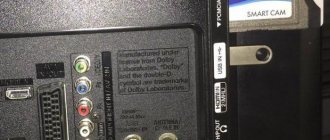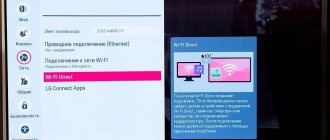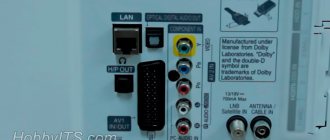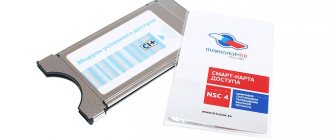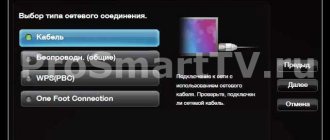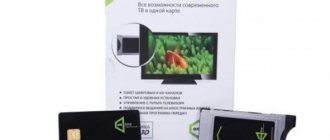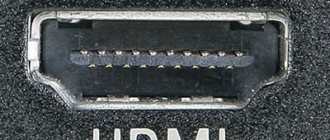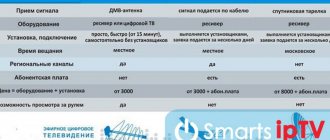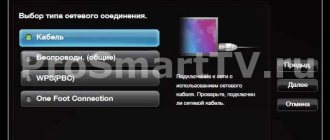Many users buy new Smart TVs (Samsung, Philips) and, when studying their capabilities and slot panel, find the Common Interface connector. We will tell you what it is and why CI is needed.
“CI+ modules” or Common Interface is a special slot on the back panel of the TV for integrating a module with a card from a satellite television operator into it. It is the card that decodes pay TV channels and allows the user to view them. CI+ acts as protection against illegal viewing of pay TV channels. Used for digital broadcasting.
Allowable number of dead pixels
You can often see a picture in stores when a buyer tries to return a newly purchased TV after discovering defects on the screen, in particular, dead pixels. For the sake of truth, we note that usually a dispute between a store and a buyer ends not in favor of the latter. To avoid getting into an unpleasant situation, we recommend choosing a TV very responsibly. In particular, it is worth knowing how to check an LCD TV at a retail outlet when purchasing for dead pixels, and become familiar with certain standards, according to which displays are divided into four classes.
| Class | Constantly lit (white) pixels | Constantly off (black) dots | Defective subpixels (color) |
| per million pixels | |||
| I | |||
| II | 2 | 2 | 5 |
| III | 5 | 15 | 50 |
| IV | 50 | 150 | 500 |
How to use?
Using Samsung Smart TV is no more difficult than using a regular series phone. Basic setup consists of the following steps:
- Set up terrestrial and cable TV channels. Just use auto-tuning in the device menu. Satellite television channels are found through the operator selection menu from the list or automatically after setting up the receiver.
- Recover your own data from online services. On some IPTV players you can create and save playlists from the cloud. Most online cinemas also have this option.
- Reboot. This action is performed from the remote control. For series D, C, B, exit to the service menu by long pressing the Exit button and then selecting the “Restore settings” item. For E, F, H, J, K, M, Q, LS - through “Menu”, “Support” and “Self-diagnosis”, selecting “Reset” and entering the PIN code.
- Set the timer to turn off. You need to press TOOLS on the remote control, and then select the desired option and time period.
- Clear cache. It's easy to free overloaded memory. You can clear the cache through the main menu, in the browser settings, or by deleting history.
If you need to connect a smart TV to a microphone for karaoke, wireless headphones or external speakers, or a smartphone to stream music, you can use the Bluetooth module by simply synchronizing the device.
CAM module what is it
CAM (Conditional-access module) is an electronic device used in modern televisions and digital television receivers to provide subscribers with access to encrypted channels (in other words, for decoding or decoding) in digital television.
The CAM module is a small electronic unit the size of a bank card. Having, on the one hand, a slot for a smart card and a CI connector for connecting to a TV, on the other hand.
CAM modules from different satellite operators are similar in appearance, but you cannot use a module, say NTV+, in the Tricolor system. Each operator uses its own encoding system; Tricolor TV uses DRE CRYPT.
IN
Disadvantages of this solution: for the satellite receiver you will have to allocate a place next to the TV; connect it to the power supply; connect the receiver and TV with an HDMI cable; control the system using 2 remote controls.
IN
In fact, the CAM conditional access module is quite small in size - about the size of a bank card.
- Advantages of the CAM module:
- less price;
- does not take up space;
- does not occupy an outlet;
- no connecting wires;
- The TV remote control is used.
CI slot on TV - what is it?
- CI (Common Interface) is an interface for connecting electronic modules, available in the design of modern televisions (made on the basis of the PCMCIA connector):
- digital television receivers;
- or specialized boards for viewing closed (encrypted) radio and TV channels.
The CI slot is located on the back of the TV and in our case is used to connect a CAM module:
CI card for Samsung TV, what is it? Common Interface on Samsung TV, what is it?
Samsung TVs use exactly the same CI+ (Common Interface) connector as we discussed above. It is used to connect CI cards, such as satellite TV CAM modules.
CI CAM module LG what is it?
Likewise, this is a CAM module that can be plugged not only into LG TVs, but into any others that support CI+.
Missing CI CAM module LG how to fix? Missing CAM module LG TV what should I do?
The Cl CAM module is necessary for decoding paid channels of satellite or cable television - purchase such a module and subscribe to the tariff you need. If you have such a module and this message appears, try removing and plugging in the CI CAM module again while the TV is turned off.
What to do if you receive the error “There is no CI module in the LG TV”
You can download instructions for setting up a list of TV channels for TVs with a CI module from the provider’s official website. If the user is sure that his device is equipped with a CAM module, but when trying to set up an LG TV, the error “No CI module” appears, then it is recommended to check the selected signal source - the password stored on the Smart card can only be read in the “Cable TV” mode. To avoid repeating the system error, new parameters must be saved into the memory of the television device. A failure may also occur due to an outdated version of the television software.
To update the firmware, the user will need:
- download the latest version of webOS from the official LG website;
- transfer the downloaded file to a USB drive previously formatted in FAT32;
- connect the USB flash drive to the TV and run a manual software update.
When webOS is updated, all that remains is to complete the playlist of pay TV channels. Another solution to the problem is to change the user’s region of location in the TV settings - when editing an account, it is recommended to select “Germany” or “Finland” as the country of residence. It is worth noting that setting a new parameter will not affect the functionality of webOS in any way.
Conclusion
Now the user knows what CAM and CI modules for a TV are. To successfully install a Smart card, you must use only the network parameters proposed by the provider - otherwise the microchip will not be read, and the TB device system will definitely generate an error.
As you might guess, to receive your encrypted TV channels, including high-definition TV channels, on any user device.
But with the caveat that it accepts satellite TV in DVB-S2 format and supports CI+ technology.
CI+ module. This is an electronic module with an expansion slot in the design of modern televisions and digital television receivers, which allows you to view closed radio and television channels using an inserted CAM module and card. CI+ technology, unlike CI, allows you to additionally protect content from copying.
What is not good for the user. I consider any restrictions to be bad and humiliating for us, ordinary respectable users.
Those who have chosen the path through life with an official NTV+ card or another operator.
And so, on October 1, 2013, NTV-Plus announced a CI+ module with which you can receive NTV-Plus channels without using receivers recommended by the company. Following NTV-Plus, Tricolor TV also presented its access module
Let me remind you:
To receive the NTV-PLUS satellite signal, the TV must support DVB-S and DVB-S2 standards
Regular CAM modules are modules of the CI (Common Interface) standard, and new pay TV modules work with the new CI+ standard
These modules do not work with all, not all, equipment.
It is interesting, of course, for what reason the choice was made in favor of a little-used standard. Probably there was a desire to make more profit.
And so...satellite receivers with CI+ support (Only with certain software versions)
TVs with CI+ support
With TVs everything is more complicated. Sellers from specialized stores or online sites will help you find a TV with CI+ support.
You should look for models with a built-in DVB-S2 and/or DVB-C tuner from the latest 2 series of the most popular manufacturers: Samsung, LG, Sony, Philips, etc.
But this is also not a fact!
Below, watch the adventure with the new LG TV.
The pay TV market players offered a solution that people have been waiting for a long time, but, alas, it is far from optimal.
People were given the opportunity to choose, but they did not think about the convenience of making this choice.
Excerpt from Wikipedia:
The new version of CI+ (CI Plus) works with "Reverse Encryption." This means that the data remains encrypted even before it is directly transmitted to the screen.
The new standard meets the requirements of data owners. Thus, recording something from a device equipped with this version of CI becomes, at the moment, impossible.
Only special players that are compatible with this format are supported. The content owner can then disable recording or allow viewing only once, or disable ad rewinding or disable HD recording.
You probably know what dancing with a tambourine means?
Exactly…
Read an excerpt from a forum about a TV that should support the innovation:
I have model 47LM670T, released 02/2013.
When using a CAM module from MTS. Here's the whole story from the very beginning of installing the CAM module...
Engineers from MTS came to install the CAM module according to my request, poked around for about an hour, but everything stalled on error E120-4, they left, saying that they could install a set-top box, everything would work with it, but this option was not suitable for me, because...
The TV hangs on the wall, and all the wires are pre-walled into the wall, so I didn’t want to spoil the view for the sake of the set-top box, and it was just a shame - the TV was new, there was the right connector, but some one didn’t work.
I read several topics on different forums about this error, it turned out that I was far from alone with this problem, in addition, it turned out that most often people complain about TVs from LG 6xx series.
I tried all the manipulations that were recommended on the forums (updating TV software, resetting TV settings, tuning in Switzerland, Germany (Finland was not present), remove/insert the module on different channels, wait several hours with an error on the screen, etc.), nothing did not help.
I called MTS support and they said that most likely my TV does not support CI+ technology. I called LG support and they said that my TV supports CI+ technology and most likely the problem is in the CAM module from MTS and it needs to be reflashed (???).
I called MTS again, they don’t know about flashing, they offer to arrange for engineers to visit and install a CAM module with a reference setting. Engineers arrived and replaced the CAM module and card, but this did not help, the same error again: E120-4...
I also read the forums, nothing new... I call LG, give the whole schedule, they offer to arrange a visit from their service technician, BUT they say that if the problem is not with the TV, I will have to pay 1600 rubles. for leaving, I say that if in case of failure they can prove to me that it was not a TV issue, then ok.
The next day, an LG service technician from my city calls, finds out about the problem and promises to clarify the information with LG technicians (asks for the serial number, warranty card and other TV data). The next day, another call from the service technician, informing that the main board on the TV needs to be changed (he called it the main board), because... The TV is under warranty and will be completely replaced(!) at LG's expense.
Finally, there was real hope for a successful outcome. We agreed on a replacement time. A competent service technician arrived, took off his shoes, put on shoe covers (!), changed the board in half an hour, hung the TV on the wall together, due to the replacement of the board we had to set up the TV again (set it up in Switzerland, frequency 298000, only digital, other parameters are default) turned on the TV to the encrypted channel, turned it off, inserted the CAM module, turned on the TV and after 10-15 seconds all channels were decoded and working!!! HOORAY!)
This is such a thorny path we had to go through.
I asked how much this board cost, it turned out its price was about 6,000 rubles, here (as far as I understand, the previous board still did not support the required technology... and according to the service technician, on the same TV models from LG but of a later release there would not be such a problem must). I hope this information helps someone!
I’m somehow not very enthusiastic about the innovations of NTV+ and other companies! And then they themselves are surprised that so many people go into the dark zone... into sharing!
Good luck, Friends!
Technological progress does not stand still, and new devices appear almost constantly, and devices that have already become familiar are equipped with additional devices. This applies to almost all types of activities, but the entertainment industry and related devices are always at the forefront of updating. However, sometimes this process happens so quickly that even fairly tech-savvy users experience difficulties. For example, among owners of the latest generations of LG TVs, the question often arises about what a PCMCIA card slot is, which can be seen on the back wall of the device. The answer will be both complex and simple, but first things first.
Smart card and PCMCIA card slot
Connecting a smart card to the TV via the CAM module
The CAM module is presented in the form of a small plastic box that is inserted into a special slot on the TV. Using a Smart Card module is a very convenient option. When connecting it, you will not need any other equipment, a large number of wires or additional remote controls.
Connecting the module is possible when the TV has a built-in DVB-C receiver for broadcasting a cable package of channels, or DVB-S for launching satellite channels. There must also be a CI connector into which the CAM module will be inserted. All modern TVs with a release date starting from 2013 meet these requirements. (in Samsung models since 2009, in Philips since 2011).
In order to activate a smart card, you must perform the following steps:
- First of all, you need to make sure that the TV is turned off. The device should not be in “sleep” mode, but should be completely de-energized
. - It is necessary to insert the card into the module all the way so that the electronic chip of the card touches the front side of the module.
- After this, the module is inserted into the desired slot.
- To check how the card works, you need to turn on the TV and, depending on the model, select the desired menu item.
If the TV does not have a special receiver, then using a smart card is only possible with a receiver. Depending on the type of set-top box, the card is inserted directly into the device or used together with the module.
What is included
The Tricolor TV company provides a choice of several sets of equipment for smart and regular TVs. Most include receivers, but some also have a CAM module. This set includes:
- Tricolor CAM module, compatible with television receivers that support the DVB-S2 satellite digital television standard;
- Tricolor smart card for TV;
- Satellite dish;
- Satellite circular converter.
It is not necessary to take a ready-made set of equipment. It is important to purchase only a smart card from the selected service provider and enter into an appropriate agreement. Next, we will look at what requirements apply to the equipment for connecting the CAM module itself to the TV, as well as how to set up Tricolor television on SAMSUNG.
Connection and setup
Common Interface is a connector on a Samsung TV and does not require any installation. CI module is a part designed for merging devices, and protection that ensures the impossibility of illegal viewing of paid channels. Designed intentionally for digital broadcasting.
Before connecting the CI module, you should understand the instructions:
- Insert the telecommunications operator card into the CAM module adapter. Place the card with the contacts facing up in line with the outside of the module itself.
- Insert the module into the Common Interface connector.
- Secure the CI module in 3 places. 2 holes for legs and 1 for connecting contacts.
- Check if everything is securely fixed. Any discrepancies may lead to problems in the image and transmission of media information.
- Connect the CAM module with a card whose purpose is unlocking. Check whether it is positioned correctly.
Video instructions for connecting the CI module:
After passing all these stages, digital television should be connected. Then you have to go to the TV settings. All actions must be performed in the “General Interface” mode. It is turned on in the “System” or “Broadcast” menu section.
The setting is as follows:
After these simple manipulations, the Common Interface system is ready for use.
What is CAM - module
CAM module – adapter for access cards to pay television channels. Abbreviation CAM
means
conditional-access module
.
The CAM
module captures streaming video, decrypts the content and sends the signal to the TV.
The card is received by a digital TV subscriber after signing up for a paid subscription to the channel. You can order a card from your television operator. Each card has a special number associated with it. You can receive temporary channel access keys to this number. Such keys are needed for CAM
-the module decrypted the TV signal and transmitted it to the TV. Keys remain relevant only for a limited period of time. The frequency with which access keys are updated is determined by the encryption algorithm.
The card is installed in the slot on the CAM
-module
For the CAM
module to work, it must be placed in
the CI
slot on the TV or receiver.
What is CI
?
C.I.
-module is a kind of intermediary between the TV and
CAM
adapter, specialized.
CI
can be designed for 1 or 2 access cards.
The modern version of the interface, CI+
, technologically complicates piracy and sets many restrictions for the content user. Some content owners make it impossible to skip ads or prevent you from downloading videos.
C.I.
-module is
the Common Interface
on the TV; it is equipped with a slot for “smart cards”. Since this is an interface, it is used to connect the television device to the plastic card adapter.
What your TV must have so that you can install a CAM module in it:
- CI
-slot; - Built-in DVB
-C tuner; - Supports HD
Ready and
Full HD
formats.
The common interface on the TV is installed to protect the interests of pay TV content providers.
How does the Tricolor TV CI module work?
How the Tricolor TV Ci module works can be described as follows: it decodes the received signal and then transmits it in decrypted form to the receiver built into the TV. The previously encrypted channels of the Tricolor TV operator become available for viewing. When using the module, it is important to monitor software updates for the TV itself, because The signal is processed by the DVB-S2 tuner built into the TV. If access to channels is terminated (the channels are encrypted), and the module and smart card are not damaged, then you need to configure the TV itself.
Principle of operation
The Smart card contains a special microchip that allows the provider to identify the customer of a particular paid TV program package.
The card is inserted into the CAM module, which in turn is connected to the TV device via the CI interface. After installing the assembled system, the user needs to configure a playlist of channels.
A device with its own CAM module, like a special digital set-top box, is capable of playing video in high resolution and recording offline TV programs that the user, for one reason or another, did not have time to watch on air. The Conditional Access Module also allows you to manually set content display parameters.
How to install a CAM module in a TV
So, you purchased a TV device with a CI slot. How to start using it:
- Face the card with the operator's logo facing you;
- Place the card into the adapter. The card chip should face up when installed in the slot;
- Then the adapter with the card is placed in the PCMCIA
slot on the TV. In this case, the television receiver should be turned off, and the adapter should be turned facing outward; - Only then turn on the device. On its screen you will see a warning that a new device has been connected;
- To make sure that the CAM
module is working correctly, go to the automatic program search. You will see the connection status in the device menu.
Common interface
what is it - this is an expansion slot, now installed in all TVs that have digital tuners of the DVB standard, this is nothing more than an electronic module with a slot, a CAM module is installed in the slot, and an access card is installed in the module.
How to configure the Ci “Tricolor” module on a TV?
Module "Tricolor TV" Ci: how to connect and configure? This procedure is quite simple. To connect the Tricolor TV conditional access module, first you need to make sure that your TV is equipped with a Ci-slot, purchase a CAM module and a smart card. To connect the Tricolor TV Ci module, you need to insert a module with a smart card installed in it into a special port on the TV. This must be done with the TV turned off. Now let’s figure out how to set up the Ci+ “Tricolor” module on your TV. After turning on the TV, information about identifying the module and the Tricolor TV smart card should appear on the screen: “Attention, access rights are being checked.” If the check does not occur, then go to the Ci module settings and click on the “Reset to factory settings” button. The TV will reboot. When the module is identified, a green light will appear on it. After this you need to configure the channels. In many modern TVs (especially Samsung and LG), channel tuning is carried out automatically when you select the Tricolor TV operator. If your TV does not support this mode, then you need to manually enter the parameters: type of antenna, satellite, converter. If you managed to do all this, then move on to setting up channels in the corresponding section of the menu. Request channel search frequencies in advance from Tricolor TV technical support or look on the Internet. After you finish setting up the channels, leave the TV on the Russia-1 channel until the programs are activated (from a few minutes to 8 hours).
Actions if the module does not connect
Many users are faced with a situation where the installation process is completed, but the module does not connect. In many cases, the problem can be solved within a few minutes:
- The most common errors include incorrect installation of the card or the adapter itself. To eliminate errors, you should turn off the household appliance from the network, remove the adapter, install the card correctly and place the module in the slot. After this, we check the notification about connecting a new device by connecting the TV to the electricity network.
- After connecting, it is possible that the channels are not configured. If the equipment is connected according to all the rules, and the TV finds a new device, but does not connect channels, you should contact your service provider for advice.
- If there is no automatic connection, TV channels are configured manually.
Televisions are one of the essential household appliances in the home. They differ in size, production technology and additional functions. Among the wide variety presented on the modern market, every buyer will be able to choose the best option for himself. TVs with an additional CI module are becoming widely popular. Such a device will become a full-fledged family member in any home.
How to update the CI module "Tricolor" TV?
For continuous display of channels and correct operation of the Tricolor TV Ci module, it is necessary to promptly update: the software of the TV and the module itself. If the TV is connected to the Internet, set “Automatic software update” in the settings, then it will happen automatically. If it is not possible to connect your TV to the Internet, then follow the updates yourself on the manufacturer’s website, download to a USB flash drive and update according to the instructions via the USB connector. The module software is updated via satellite. All you need to do is turn on channel number 333 “Telemaster”, which will offer to update to the latest version, and click the “OK” button. After installing the update, the module should automatically reboot. If this does not happen, you need to turn off the TV, remove the adapter from the slot and put it back, then turn on the TV. If for some reason you were unable to update automatically, you can download instructions on the Tricolor website that describe how to update the Tricolor TV Ci module yourself by downloading files with the latest version of the software to a USB drive. If nothing works, you can contact the Tricolor TV support service or call a wizard to configure the module.
Connection and setup
Common Interface is a connector on a Samsung TV and does not require any installation. CI module is a part designed for merging devices, and protection that ensures the impossibility of illegal viewing of paid channels. Designed intentionally for digital broadcasting.
Before connecting the CI module, you should understand the instructions:
- Insert the telecommunications operator card into the CAM module adapter. Place the card with the contacts facing up in line with the outside of the module itself.
- Insert the module into the Common Interface connector.
- Secure the CI module in 3 places. 2 holes for legs and 1 for connecting contacts.
- Check if everything is securely fixed. Any discrepancies may lead to problems in the image and transmission of media information.
- Connect the CAM module with a card whose purpose is unlocking. Check whether it is positioned correctly.
Video instructions for connecting the CI module:
After passing all these stages, digital television should be connected. Then you have to go to the TV settings. All actions must be performed in the “General Interface” mode. It is turned on in the “System” or “Broadcast” menu section.
The setting is as follows:
After these simple manipulations, the Common Interface system is ready for use.
How to connect and configure?
If the CI module is a separate adapter that comes with the TV, then the Common Interface is an integrated slot. The installation process of a card previously purchased through a telecommunications service company must be carried out in accordance with the instructions, which we will study a little later. Most modules contain information about the direction in which the integration is taking place. Before installation, information about the decoded channel will be displayed on the screen. After installing the card, this inscription should disappear.
When you install the CI module for the first time, your telecommunications service provider and user information will usually appear on the screen. Such changes on the TV screen will indicate that the module and card are connected correctly
Common Interface slots are sensitive to external damage and can be easily damaged if handled carelessly, so caution is a good idea. To connect this module and prepare it for further work, you need to follow simple instructions
We place the provider card in the CAM module adapter. It is usually purchased through the operator that provides television services. The card must be placed with the contacts facing up, if you are guided by the front side of the module. Now you need to integrate the adapter. To do this, you need to remove the protective sticker on the TV, under which the slot is located. Insert the CAM module into the corresponding connector. We fix it at three points. Two fixing holes are intended for the legs, and the third is necessary for connecting the contacts. At this stage, you need to check the connection density, since any inaccuracy and play will cause problems with the quality of broadcasting TV programs. We connect the module already with the card, inserting it all the way
It is important to check that the location is correct.
If everything is done correctly, then digital television should be connected. All that remains is to configure the TV according to the following instructions:
- setup is carried out in the “general interface” section - the entrance to this section will differ depending on the model and brand of the TV; in some cases, entry is made through the “Broadcast” menu; There are also systems in which login is carried out through the “System” menu;
- Now you can proceed to setting up channels - to do this, go to the menu, select the “Settings” tab, and then “Channels”;
- select the auto search function and remove the check mark from terrestrial channels, moving it to satellite or cable channels, focusing on the type of cable connected to the LNB;
- select one of the available search options and wait for the system to configure blocked channels.
If everything was done correctly and no problems arose during the connection, then the “Common Interface” will be in the active state. Otherwise, you will need to disconnect the TV from the power supply and reconnect the adapter and module. In rare cases, the "Common Interface" may be in an active state, but the channels are in an encrypted state. To solve a problem of this nature, you will have to re-tune the channels. If you have a spare CAM module, you can use it to perform the test. If none of this helps, then you will have to contact a company that provides television broadcasting services.
What is a CI module and why is it needed, see below.
How to set up the menu on TV?
All settings are carried out in the “general interface” section. In each model it will be called differently, but there is a certain sequence of actions:
- In any of the models you need to find the “Broadcast” or “System” section;
- If there is no activity, then you need to check that all modules are connected correctly or completely reboot the TV.
Then in the “General Interface” section you can see whether there is activity or not;
If the connection does not appear, then there are two options. You can try changing each connection element yourself to a new one, perhaps this will help solve the problem. But the easiest thing is to call a specialist to your home, who will look at everything and find the reason why there is no connection.
Source
Mode of operationedit
A DVB receiver may have one or two slots implementing the Common Interface (CI). The CI uses the conditional-access module (PCMCIA) connector and conforms to the Common Scrambling Algorithm (CSA), the normative that specifies that such a receiver must be able to accept DES (Data Encryption Standard) keys in intervals of some milliseconds, and use them to decode private channels according to a specific algorithm. Those algorithms are proprietary to individual suppliers. Each one uses their own algorithms and there is no defined standard for them.
As the full MPEG-2 transport data stream comes out of the demodulator, and error correction units, the DTV Receiver sends it through the card plugged into the Common Interface, before it is processed by the MPEG demultiplexer in the receiver. If several CI cards are present, the MPEG transport data stream will be passed sequentially through all these cards.
An embedded CAM may not physically exist, as it may be in CPU software. In such a case, only the smart card reader normally in the CAM is fitted and not the PCMCIA type CI slots.
Even if the Common Interface has been created to resolve cryptography issues, it can have other functions using other types of modules such as Web Browser, iDTV (Interactive Television), and so forth.
In Europe, DVB-CI is obligatory in all iDTV terminals.
The host sends an encrypted MPEG transport stream to the CAM and the CAM sends the decrypted transport stream back to the host. The CAM often contains a smart-card reader.
What types of CAM modules are there?
According to technical specifications, the entire range of manufactured conditional access devices to encrypted channels are divided into types. The simplest modules are T2 and single-channel with support for only one encoding system. Multi-channel and universal models are also offered.
- The single-channel module is capable of decoding paid channels broadcast only by the selected provider (satellite). If you change service provider or satellite with a different broadcast system, the module becomes inoperable.
- Multichannel device models allow you to switch from one encoding system to another using SIM cards from different providers. The device automatically recognizes the inserted SIM card, rebuilds itself and updates the software.
- Manufacturers are flashing a universal module to work with several signal encoding systems. The device can automatically adjust signal parameters, configure programs, and work with SIM cards from any provider. Suitable for working with paid software packages.
If we talk about the cost of the module, then in specialized stores you can see a fairly wide range of prices. As a rule, the cost of the first option ranges from 1,500 to 3,000 rubles. The price of more modern models varies around 5000-6000 rubles. Experts recommend not to opt for too cheap options. Otherwise, this will lead to a quick replacement as they cannot cope with the latest technology, and the purchase will end up being much more expensive than planned.
What types of Tricolor TV CAM modules are there?
Custom CAM modules for viewing Tricolor TV are produced in only one format: single-system, single-channel. They are easy to set up and operate and provide access in the DRE-crypt encoding system on a single TV. Universal multi-channel modules, with which you can watch several channels simultaneously on different devices, are too difficult to set up and require special expensive equipment to operate.
Single system option
Universal option
Universal modules are capable of supporting several channel coding systems and broadcasting different channels to subscribers on the television network. You will watch the channels of the operator whose smart card you purchased and inserted into the module. But to operate such devices, you need special expensive television stations and complex programming and configuration of equipment. For this reason, universal modules are used only when connecting a large number of subscribers, for example, in apartment buildings.
What is a CI module on a TV?
The CI module (the abbreviation stands for “Common Interface”) is a special connector into which an access card to pay digital television is inserted.
Using this interface, the video stream received from the provider is decoded and the signal is matched with the TV system.
The device connected via the CI slot is called a CAM module (Conditional Access Module), and it is this device that performs the function of unlocking encrypted channels: CI is just a port for the CAM, which in turn is an adapter between the TV and the Smart card.
The smart card contains a special password that allows a person to access cable television. It is worth saying that manufacturers claim support for CI and CAM only in those TV models that also have their own DVB tuner.
Among the advantages of purchasing such a Smart TV:
- Saving money. If the TV device is equipped with a CAM module, then the user will not have to additionally purchase an external digital set-top box - to access the broadcast of TV channels in high definition, you will need to pay for the selected TV package and receive a free Smart card from the provider.
- Easy equipment setup. The process of connecting a Smart card to an LG or Samsung TV is similar to installing a regular microSD into a smartphone, and setting up the equipment usually takes no more than 2 minutes.
- Compactness of the system. Externally, the CAM resembles a bank card several centimeters thick, which is significantly smaller than a conventional digital set-top box. Also, to use this module there is no need to connect additional wires to the display.
- Easy management of TV programs. When using CAM, television viewing is controlled through the television rather than the DVB-T2 remote control.
The operating principle of the CI-card smart card adapter for Samsung and LG TVs will be described in a little more detail in the next section of the article.
What is a smart card and PCMCIA card slot
The answer to the question posed above should begin from afar, namely, consider such an innovation as a smart card for cable television. The familiar form of television broadcasting is gradually becoming part of history, and cable channels are taking its place. This process is completely natural and natural.
In this case, there is a need to organize address broadcasting and an appropriate security system that excludes the possibility of unauthorized connection. Laying cable networks to the user and maintaining them in working condition requires significant financial investments on the part of supplying companies, which directly affects the cost of tariffs. At the same time, there must be certain protections to ensure that the person who paid for the service will use it. This is one of the few cases where both the client and the company are on the same side. The only question is how exactly to organize the possibility of limiting broadcasting. The answer to this was the development and implementation of smart cards and PCMCIA card slots in LG TVs.
Smart card and adapter
Smart card
is a small device (essentially a card) that performs the function of a pass. That is, certain information is entered on the card regarding the owner, the tariff he purchased, additional services connected, etc. This card is connected to the TV using a slot in the PCMCIA card slot format.
Initially, the technology was developed for use in laptops and its intended purpose was to connect various additional peripheral devices, such as additional memory drives, network cards, modems for Internet access. However, over time, application was found in cable television. I think you understand what a PCMCIA card slot is and why it is needed.
Using smart cards for access allows you to achieve a number of advantages:
- Possibility of direct management of connected tariffs and channel packages.
- Increased security of use - no one will be able to access channels if the card is not physically installed in the slot.
- If the equipment is compatible, you can take your channel package with you, which is very convenient.
Smart card installed in the slot
At the same time, if the LG TV is equipped with a built-in PCMCIA card slot, then all actions for using the smart card are reduced to simply installing it in the designated slot.
How to enter the TV service menu
To enter the service menu, you must have a standard TV remote control (below is a photo of a standard remote control). The standard remote control has more control buttons, some buttons are used to enter the service menu. The smart remote control is not suitable for entering the service menu.
standard Samsung TV remote control
Warning: you must work with the service menu carefully. Incorrect actions may result in the inability to turn on the TV
By entering the service menu, you take full responsibility for the further operation of the TV at your own risk.
Common Interface on Samsung TV - what is it?
Today, analogue television is being actively replaced by digital television, and the need for signal converters is disappearing. Instead, more convenient designs are used. The Common Interface on a Samsung TV is an integrated slot located on the rear panel. The literal translation from English is “Common Interface”. The device is also known as “CI+ module”. It is an alternative to a stand-alone tuner and is used in digital broadcasting with a high level of quality. In this article we will look in detail at what this slot is, why it is needed and how to set it up yourself.
What is Common Interface on Samsung TV
Common Interface (abbreviated as CI) is a connection system for CAM modules with a card, which allows you to watch closed pay channels by reading information from a decoding card. This device is used in most modern TVs.
Common Interface slot
To gain access to viewing paid channels through the Common Interface, you must have two more components.
CAM module or conditional access module - inserted into the CI, it is essentially an adapter between the card and the interface of your Samsung. It often comes complete with a card, but sometimes you have to buy it separately.
Electronic decoding card or “Smart card” - inserted into the CAM module. Contains information for accessing paid channels, i.e. serves as an identification document. Purchased from a digital television operator. Which channels can be viewed is determined by the terms of the tariff and the contract you entered into with the service provider.
CAM module and card for TV
The advantage of the CI+ module compared to the receiver is its compactness and lower cost. It is integrated into the TV and does not require additional space, nor does it need a separate control panel.
How to install and configure Common Interface yourself
The module should be connected to the connector carefully to avoid mechanical damage. The power must be turned off to avoid any malfunctions.
Step-by-step instructions on how to connect and configure Common Interface on a Samsung TV
Installation
1. Remove the protective sticker that covers the hole for the Cl+ module.
2. Connect the Common Interface slot to the corresponding connector and secure it at three points - in two holes for the legs and one for connecting the contacts. Make sure everything is connected tightly without any gaps, this may affect the quality of the TV broadcast.
3. Insert the decoding card into the CAM module.
4. Insert the CAM module into the slot.
Settings
Navigation may vary between brands and TV models. For some it will be the “Broadcast” item, for others it will be “System”, other versions are possible.
First option: – Menu – “Broadcast” – “Antenna” – Your TV type (NTV+, Tricolor, etc.); – Menu – “Broadcast” – “Channel List” – “Scan”; – wait for the channel setup to finish.
Second option: – Menu – “Settings” – “Channels” – “Auto search”; – uncheck terrestrial channels and add to cable or satellite, depending on what type of cable you have connected to the LNB; – select your TV type and start auto search; – wait while the blocked channels are configured.
After these steps, access to TV shows should be activated. If this does not happen, perhaps some failures occurred during the setup process or there was a problem in the contacts of the system modules. Turn off the TV, remove the CI+ and CAM module, and reconnect everything again. Access is active, but the channels are encrypted - leave the TV on one of the channels for a period of 1 to 8 hours. Then perform the setup again. If it does not help, the reason may be in one of the components. If you have a spare CAM module, try using it to check the serviceability of the one you are connecting. If it doesn’t work, contact your provider; the problem may be in the CAM module or card.
Installing a CI+ conditional access module (Tricolor) into a Samsung TV
Settings in the TV menu
Actions to configure the menu should be performed in the “general interface”
.
- Different TV models may have their own correct paths to access the “general interface” section. You should go to the menu and find one of two items: System
or
Broadcast
. - The “General Interface” should indicate its activity, if this is not observed, then follow the following options.
- Remove all components and reconnect everything. The TV needs to be unplugged from the network; a simple reboot may not help. Make sure your actions are correct. The operator card is included in the CAM module, it should be included in the CI module, and it is already integrated into the Common Interface.
This is the only valid way to establish a connection with a TV channel operator. If for some reason access was not given, then try replacing each of the elements with others. We replace all components one by one and calculate possible non-functioning components. Here is a visual video showing the connection of this module.
This instruction is suitable for many modern plasma panels, such as Samsung, Philips, etc.
There is always the possibility of contacting the operator’s technical support
contacts for clarification of the situation. Take all the elements and the decoding card with you. Employees will be able to check the functionality on site. If necessary, it is better to order a specialist to come to your home address.
The standard connection diagram for Tricolor satellite television is as follows: satellite dish - receiver (receiver) - TV. If you have a modern TV model, then this chain can be simplified: instead of a separate TV set-top box, use a CAM module. What it is, how it works, how to connect and how to configure the Ci “Tricolor TV” module, we will consider further.
Setting up Tricolor TV with CI module
1. Simply install the CAM module into the CI+ slot of the TV to which the satellite dish is connected (tuned to the Eutelsat 36 degree satellite), and after a few seconds the TV will offer to automatically search for Tricolor TV channels. That is, there is now no fuss with manually entering transponder frequencies, as was the case with previous versions of Tricolor TV modules, all this is already hardwired into the module itself.
2. If you come across a module with old firmware, the algorithm will be slightly different. We turn on the TV. If the TV sees the card, it will begin checking access rights. This may take a little time. Next, a message should appear that the test was successful and you can begin setting up channels.
If you have a regular remote control, then press the “Setting” button. If the remote control is a magic remote, then the “Input” button and select the settings symbol. We get to the quick settings menu.
- In it, select “Channels”.
- Next, “Search for channels.”
- Then go to “Autosearch”.
But if you want to make sure that the card is connected, then you need to go to the “CI (CAM)” item, then “Information” and there, on the name of the card that you bought. It should contain various information about your card.
In the auto search menu, check the box next to “Satellite”. And click “Next”. Select your card operator. In this case, “Tricolor”, “Next”.
In the next menu you can configure the satellite manually, but for major operators the settings are set automatically. Click “Next” again.
Next comes the settings menu. For a regular search, uncheck all the boxes and click “Run”. The channel search begins. It may take several minutes. After completion, the window will show how many channels and radios have been found.
Click “Finish” and enjoy satellite TV.
On LG TV
Setting up a Tricolor with a C+ module on an LG TV is not difficult and follows the instructions above.
- But turning on and setting up favorite channels threw me into a stupor, everything was so unclear there:
- To start working with your favorite channels, press the gear button on the remote control and then select Advanced settings - Channels - Channel editor - Edit favorites.
- We go to the list of all channels and check the boxes next to those channels that we want to add to Favorites (in this case, the channels can be viewed in a small window).
- Click the Apply button (right arrow icon).
- Next, select Sort and Filter.
- That's it, now only your favorite channels will be displayed and shown. Enjoy watching.
equipment requirements
The first thing that a Tricolor user must configure is an antenna that must pick up the frequencies of one of the satellites: Eutelsat 36B, Express-AMU1, Express AT1. Then you won’t have to set special settings for the CI slot: everything will happen automatically.
One more caveat: the slot must be CI+. This is a new version of the CI connector with reverse encryption. That is, all information will be encoded before being sent to the screen. This allows the provider to protect their data from copying. Now not all content can be recorded from such a device, but only that which will be allowed for recording. The TV must have an LNB IN port, which indicates the presence of CI+ technology.
The TV must be equipped with a built-in digital tuner that supports the DVB-S2 satellite broadcasting standard. It is also desirable that the TV receiver supports 4K UHD (Ultra High Definition Television) and HEVC (High Efficiency Video Coding format). If such formats are not supported, channels broadcasting in the specified quality will not be available.
The CAM module must match the smart card encoding. The device is connected to the TV in the usual way: inserted into the CI connector. If the TV suddenly stops seeing the smart card, you need to check that the module and slot are connected correctly. After connecting to the connector, the access rights check will begin.
Sometimes the message about checking access rights can hang for a long time. To eliminate this, the time settings on the TV must be set to automatic mode. You can also try resetting the CAM module settings to factory defaults.
The built-in tuner provides certain advantages over the receiver: there is no need to purchase a separate device, which will take up additional space.
Benefits of use
Why buy a TV with a CAM adapter input:
- CAM-module is cheaper than a set-top box;
- Ease of operation and configuration;
- Compactness;
- Commands can be sent to the CAM module via a regular remote control;
- Consumes electricity directly through the TV;
- If the TV has CI-cam, there are no hassles with a cable and an external decoder;
- Built-in digital tuners are equipped with a decoder for an HDTV system by default.
Important! The advantages of using CAM also include improved images due to the absence of an extra step in the video processing process. The CAM adapter, unlike an external decoder, does not need to convert the digital signal to analog
What is it used for?
The Common Interface on Samsung TVs is designed to integrate a module with an inserted card, which is provided by satellite television operators. Thanks to this card, the user can view paid channels that are undergoing the decoration procedure. Thus, the CI+ module is protection against illegal viewing of pay television channels. This module is designed for digital broadcasting, which is known to be of high quality.
This opinion is incorrect, since it is only an interface that provides the ability to integrate cards.
Owners of TVs with such slots can enjoy all the advantages of the interface, abandoning traditional receivers:
- It is worth noting that there is only one control panel, which is already an important advantage. In the case of a receiver, the user has to use two remote controls: for the TV and for the receiver;
- the cost of the CI module is significantly lower when compared with a receiver, which, among other things, needs to be allocated free space in front of the TV.
What is "Correct Setting"?
To begin with, what is the “correct setting”
. If you've ever been to an electronics store, you've probably noticed that all the TVs on display display differently. What is this connected with? Which one is better? Let's figure it out.
I think you will agree that a TV should not only show some picture, but also introduce as little distortion as possible into the original content. The content itself is always created with an eye to industry standards and recommendations, and the main goal of any TV is to bring to you exactly the image that they wanted to show you
Everything is important here: the actor’s skin tone, the color of the sky at sunset, and which details of the image should be visible and which should be hidden. There are international standards that describe what the image on your TV screen should look like.
All of you have probably come across the abbreviations PAL, NTSC, or HDTV, and these letters hide the properties of the video signal and various image parameters. With the advent of HDTV in our lives, most of the standards are immediately outdated, and, in fact, the most relevant now is the REC709 standard, which is used in high-definition television (HD) and Blu-Ray video.
